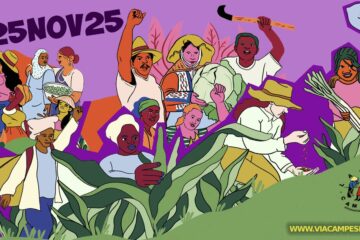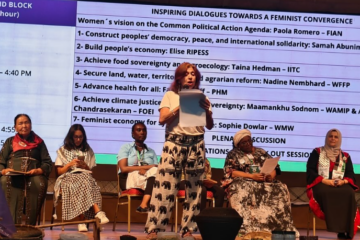The 15th Biodiversity Conference of the Parties (COP15) to the UN Convention on Biological Diversity (CBD) took place in December 2022 in Montreal. The Biodiversity COP once again discussed matters including genetic engineering, the use and trade of transgenic organisms, biopiracy, and other topics that affect not only the sustainability of human and nonhuman life on the planet, but also food sovereignty, women’s everyday lives and work, peasants, and traditional communities. Like other spaces where international negotiations are held, the Biodiversity COP represents a stage of battles between big corporations and chiefs of state, which marginalize grassroots organizations and society in general, even though they are always the ones that are most affected by their decisions.
However, over the course of all its sessions, grassroots movements have been fighting for narratives and demanding that negotiations point to system changes, and not just the maintenance of an order under which the sustainability of life and diversity are unsustainable.
More and more transnational companies have been influencing the spaces where formulations and decisions are made by expanding what they call multistakeholderism mechanism, which moves aside the major role the state has in making national decisions and legitimizes the presence of companies and philanthropic organizations in these spaces, arguing that this would increase participation and democracy. In practice, the presence of these groups has been favoring market-based solutions for environmental issues over alternatives introduced by social movements and civil society organizations.
Biodiversity Collapse
Today there are estimated 10 to 100 million species of living beings. We have recorded and listed no more than 2 million of them, considering that, because there is no unified database, many of these records are duplicated or incorrect. We know very little about so many beings that inhabit the Earth today, especially when we think about microorganisms or small creatures like worms, sponges, and crustaceans. We have barely started to take notice of the huge diversity of the web of life, only to find out it has been taken apart faster and faster over the past five centuries—and, particularly, over the past few decades.
Because we know so little about existing species, it is hard to estimate losses and monitor variations. According to the United Nations Environment Programme (UNEP), we lose 150 to 200 species a day, or, according to some scientists, 11,000 to 58,000 species a year—that amounts to a rate (so far) that is one hundred to one thousand times higher than that of any previous mass extinction.
Capitalist economic growth driven by commodities—agricultural or mineral—increasingly puts territories under pressure, resulting in loss of habitats and sharp changes in landscapes. In the case of terrestrial ecosystems, the CBD acknowledges that 70 percent of estimated biodiversity losses are agriculture-related. Not only industrial agriculture is strongly connected to increasing deforestation, it also uses pesticides and herbicides that kill millions of insects, important pollinating agents for our food. The agro-industry also has been poisoning aquatic ecosystems with its fertilizers, which contaminate water tables and create a phenomenon called eutrophication of oceans, creating dead zones for biodiversity.
Industrial activity and urbanization are also intrinsically connected to how the capitalist economy works and also lead to habitat loss and climate change. Life under capitalism only has value if it can be exploited; one way or another, the impacts of this way of life are overwhelming. As biodiversity declines, traditional ways of life that coevolved with it are also at risk. Their traditional forms of knowledge about the effects of plants, the observation of animal behavior, the ways of growing crops based on seasons, and so many other kinds of knowledge that are so important for us to build alternatives.
Precautionary Principle
The CDB has a history of ensuring and appreciating the precautionary principle. Social movements and civil society organizations point out how important it is to maintain a commitment to this principle. The precautionary principle must be applied to the development and use of different kinds of technology, including biotechnology, synthetic biology, and geoengineering. Reaffirming this common commitment is more important than ever as potentially dangerous new technologies are developed.
Movements struggling for food sovereignty are aware of the discourse of agricorporations that have been promising, at least since the Green Revolution—a mid-20th century event that triggered the capitalist industrial form of agriculture—, that technological advancements will end world hunger. Seventy years have past since these promises first started to be made, and we are still a planet full of hungry people.
While the hunger issue is not caused by an alleged lack of technological advancement, this is what companies keep saying, now based on the promise of genetic engineering. Based on this promise, they don’t have to change their business model or challenge the consumption patterns of the global North. They claim that, because this is a pressing problem, technologies could be approved without strict monitoring.
The critique of social movements is that this is a false argument, because we know that the hunger issue can be solved by fostering agroecology and reorganizing the food system, decentralizing corporate power, and we know that approving technologies thoughtlessly can lead to irreversible damage to ecosystems and communities.
Gene Drives and Sequences
One of the so-called “hot topics” around COP15 is the decision regarding the digital treatment of gene sequences of organisms and their inclusion in digital “banks,” as well as the patenting and benefit sharing process resulting from that. If this process follows transnational corporations’ will, it is very likely to promote the misappropriation of what communities own and their associated knowledge while favoring privatization processes.
Another subject of debate is regulating “gene drives,” a form of biotechnology that is newer than transgenics, with greater potential to lead to population and ecosystem imbalance. Social movements have been pointing to the need of making regulations as strict as possible, so that using this kind of technology does not affect communities and ecosystems.
Nature-based Solutions
The concepts of “Nature-based Solutions” (NBS) and “nature positive” have been playing a similar role around the CDB to the one played by the concept of “net emissions” at the Climate COP: making compensation mechanisms the center of environmental solutions.
Movements like Friends of the Earth International denounce that, regarding biodiversity, these terms imply arguing that harming ecosystems in one place (“sacrifice zones”) is acceptable as long as actions are taken to restore and maintain ecosystems somewhere else. This is a logic that does not fight the fast-paced genetic erosion we are experiencing (because species are usually endemic to their territories and cannot be “compensated for”) and actually fosters territory grabbing processes.
The Roots of the Problem
Over time, the CDB started to include gender-related topics in its discussions and decisions. However, discussing gender does not mean having a feminist stance on the matter. The CDB Gender Plan of Action is based on the Sustainable Development Goals (SDGs), as well as on the gender guidelines of other conventions and treaties of the UN System. As these negotiation spaces are dominated by private interests, the diagnoses they give ultimately stray away from the true roots of the problem, and their proposed solutions are false and insufficient.
Capitalism structures itself by rendering invisible the realms of care that sustain life, as well as by depreciating and compressing the time it takes to care for the spaces, beings, reproduction, and well-being of life.
This time compression is reflected on women’s lives, but also on the lives of other beings with which we share this planet. Capital does not pay for the care work that is necessary for life, but forces people to work at least one paid job to afford the bare minimum.
For women, who continue to shoulder the responsibility for care, this means working multiple jobs and overlapping time doing different tasks, unsustainably. For other forms of life, time compression means that ecosystems no longer have the necessary time to adapt to fast-paced habitat changes.
On the other hand, women’s connection with biodiversity inspires us toward possible alternative pathways based on the sustainability of life. Women, as well as biodiversity, show they are capable of persisting even under the most inhospitable conditions, through principles of collaboration and adaptation. Collaboration between women and biodiversity is also an ancient practice: women have learned how to get their livelihoods, healthy food, and healing from nature. Through observation and interaction, women influence the reproduction of plants, making them more diverse. They don’t just “preserve” biodiversity—they actively create it. Women operate like a repository of living memories and practices that follow the time of care and sustainability.
Grassroots movements have been taking action against false solutions and dedicating themselves to a path of change that can bring back an understanding of biodiversity as a common good and the possibility of having a relationship with nature based on a logic of care and sustainability, not one of acceleration, extractivism, and profit.
The solution for the ecological collapse that we are facing will certainly not come from Montreal, but it is also true that what has been decided in this space will directly affect the lives of the people who care for, reproduce, and create life in territories around the world.
This is why COP15 was marked by demonstrations against corporate capture. Adding to that is the participation of movements and organizations that have been monitoring negotiations to denounce this corporate capture and inform more people of what is really at stake in such negotiations. Through these alliances, a political imaginary is built affirming the struggle for agroecology, territorial rights, and care, as well as the expansion of the commons.

Lilian Roizman and Natália Lobo are militants of the World March of Women Brazil. This is an edited version of the document “Convention on Biological Diversity: Life at Stake Amid Corporate Battles at COP15,” produced in 2022 for SOF Sempreviva Feminist Organization.




